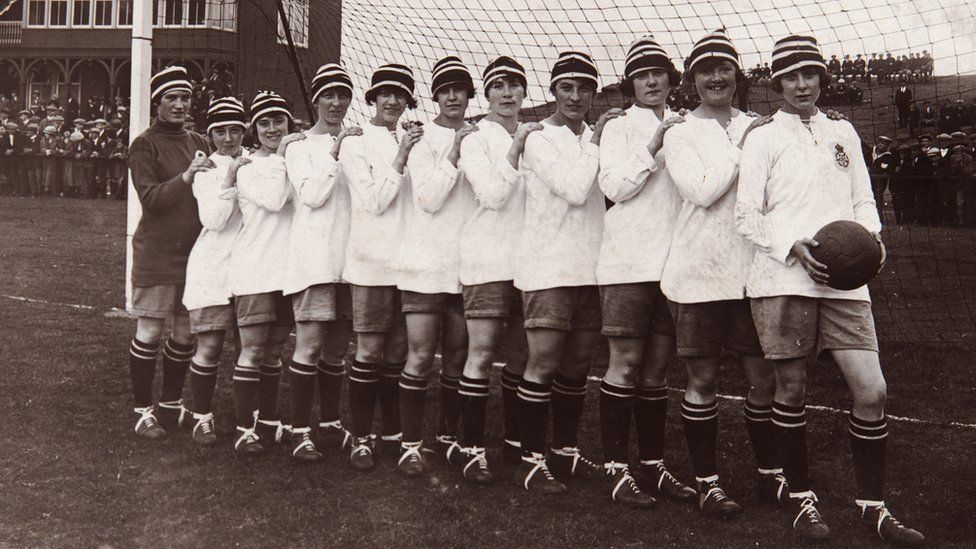On 5 December 1921, the English Football Association (FA) banned women’s football in England. Women were unable to use any of the FA’s grounds or facilities and it refused to organise any competitions. The ban lasted for 50 years. The FA introduced the ban because football was ‘unsuitable’ for women. Medical evidence, at that time, said that football posed a serious physical risk to women. Kicking a ball was likely to impose severe strain. Football was too demanding for the female body.
Any strain on the female body was not evident during the final of the women’s Euro 2022 in July, either when England’s Jill Scott and Germany’s Syndey Lohman exchanged words, or when Germany’s Lena Oberdorf, deservedly the young player of the tournament, planted England’s Fran Kirby and then Georgia Stanway into the Wembley grass. The final, watched by a record 87,192 fans, was a tense, high-quality game with England’s ‘Lionesses’ winning 2-1 in extra time. It is English national football’s first major trophy since the men’s triumph in 1966, also against Germany (West) after extra time.
The women’s Euro 2022 tournament was a huge success, encouraging record season ticket sales for the 2022/23 season of the English Women’s Super League (WSL), which started in September. On 24 September, 47,367 fans watched Arsenal beat Tottenham 4-0 in the north London derby, the biggest ever crowd for a WSL game. With WSL’s big games being played in bigger stadiums where more fans can watch, average attendances at WSL matches this season are expected to surpass the previous high of around 3,000 set in the 2019/20 season. For comparison, around 5,500 watch League Two matches – the fourth tier of men’s professional football in England.
While the England players collected a bonus of around £55,000 (Euro 62,250) for winning Euro 2020 and some also have sponsorship deals, overall, women’s football is not lucrative. The WSL only pays players about £30,000 (Euro 34,500) a year. Many of England’s current team have had second jobs during their careers to be able to play football. All need to plan for their futures when they finish playing. England’s captain, Leah Williamson, is studying accountancy to prepare for life after football. Jill Scott, who won the Euro’s this year, also played in the England team that lost 6-2 to Germany in the final of the Euros in 2009. That England team comprised mainly part-timers. Scott, who retired from football this year, now runs her own coffee shop.

England, Europe and the world
Importantly though, Women’s football is being taken increasingly seriously.The WSL, Women’s Champions League and the Women’s World Cup will all be followed by bigger crowds and television. Of the 12 teams in England’s WSL, Chelsea want to win their fourth consecutive title. Arsenal, who finished second last season, just one point behind Chelsea, want to stop them. Manchester City, Manchester United and Tottenham will look to close the gap on these two teams, while newly promoted Liverpool, returning to the WSL after two years, will be happy to finish in the top half.
The Women’s Champion’s League group stage starts in October with 16 teams, from 10 countries, in four groups. Champions Lyon will start their group stage against Arsenal. Lyon, eight times European champions, along with Barcelona, who lost 3-1 to Lyon in last season’s final, again seem to be the strongest teams in the competition. Wolfsburg won the German women’s Bundesliga for the seventh time in 2021/22 and are also among the favourites. FFC Vllaznia Shkodë from Albania qualified for the group stages for the first time this year. They will do well to progress from a group in which they play Real Madrid, Paris St. Germain and Chelsea.
The Women’s World Cup will be held July–August 2023 in Australia and New Zealand. Some 29 of the 32 countries that will be represented have already qualified. Along with European countries, the presence of teams from China, Vietnam, Morocco, Zambia, Brazil and Argentina shows the breadth of interest in women’s football. The United States has won the last two women’s World Cups and are favourites to win a third. The US will face a tough challenge from Sweden and Germany, ranked second and third in the world, and from Spain and France. England’s Lionesses, ranked fourth, also have a chance. England have beaten all the teams classed above them this year, beating the US 2-1, in front of 77,000 fans, in a friendly in October 2022, but all those matches were at Wembley.
From fear to favour
Before the game against the US, England honoured the women of its first ladies’ team, which wasformed after the FA’s notorious banwas lifted in 1971. In their first international match in 1972, England’s women beat Scotland (who else?) 3-2.Thewomen players from that match were given their official England ‘caps’. It was recognition, finally,after 50 years, that they had represented their country as footballers.

Back in 1921, the FA imposed it’s ban not because it worried about the effects of playing football on women’s health, but fear of the growing popularity of the women’s game. During the First World War, with men’s football cancelled, women working in factories organised their own teams and fixtures.By1921 there were 150 women’s clubs in England, including Stoke United. In December 1920, 53,000 people watched Dick, Kerr Ladies FC beat St Helens Ladies 4-0 at Everton’s Goodison Park. The ban was a panic reaction to the further encroachment of women into what men traditionally regarded as their world. In 1918,women in the UK had won the right to vote, it was unthinkable that they should be allowed to play football as well.
A century later, large crowds watching women play professional domestic and international football is no longer seen as a threat. That it ever was, and that it took the FA 50 years to acknowledge fully the women who have played for England, just seems ridiculous. After all, when you think about it, being able to watch female athletes demonstrate strength and skill to play and win for the people watching them on the big stage, what’s not to like?


